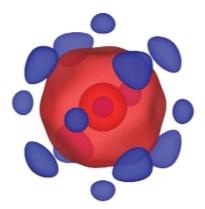Shapeshifting atoms inside Earth
Atoms are commonly thought of as being round. New CDAC-funded experimental work by a team from UC Berkeley, Northwestern University, and HPCAT, Argonne National Laboratory, reports that pressure causes iron atoms to change shape deep inside our planet, however. This shapeshift alters the physical and chemical properties of crystals at depth, influencing the way Earth has evolved over its multi-billion-year history.
The high pressures of Earth's interior can be reproduced in laboratory experiments that squeeze minerals samples between the tips of two diamonds. Previous experiments have shown that the electron clouds making up iron atoms within minerals collapse under less than a million times atmospheric pressure, conditions at roughly one quarter the depth toward our planet's center. Dubbed an electronic spin transition, the change affects the electrons involved in chemical bonding between iron and other atoms, as well as the shape of the atoms.
This change in shape of the iron atoms has now been directly imaged for the first time at high-pressure, using high-intensity x rays from the Advanced Photon Source at Argonne National Laboratory. In their collapsed form, the iron atoms look like cubes with the corners cut off, and this affects how light, heat, and sound are transmitted through crystals containing iron.
Seismic waves from distant earthquakes are used to illuminate Earth's interior, just as ultrasound is used for imaging the human body in medicine. High-pressure laboratory measurements are crucial for interpreting these seismic images and understanding the processes by which the interior cools over geological time.
Beyond imaging the shapes of atoms, the new measurements provide direct tests – means for improvements – of modern quantum simulations because the distribution of electrons within crystals is among the prime results obtained from atomistic theory. Quantum theory is widely used to develop new materials for society.
Atomic imaging at deep-Earth pressures is now a reality that can be used in basic science as well as applied technology.
The work was led by CDAC-funded graduate student, Matthew Diamond – now a postdoc at University of Illinois Chicago – as part of his Ph.D. thesis at UC Berkeley.
For more information, see: Diamond, Matthew R., Guoyin Shen, Dmitry Y. Popov, Changyong Park, Steven D. Jacobsen, and Raymond Jeanloz. Electron Density Changes across the Pressure-Induced Iron Spin Transition, Physical Review Letters 129, no. 2 (2022): 025701

